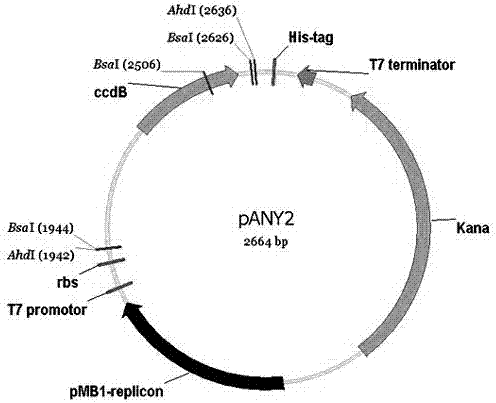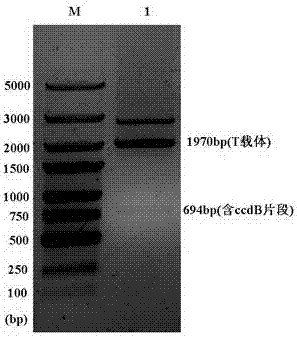Plasmid vector and construction method thereof
A technology of plasmid vector and construction method, which is applied in the field of genetic engineering, can solve problems such as inability to orientate the cloning process, false positives outside the clone, deletion, etc., and achieve the effect of convenient protein purification
- Summary
- Abstract
- Description
- Claims
- Application Information
AI Technical Summary
Problems solved by technology
Method used
Image
Examples
Embodiment 1
[0045] Embodiment 1: the acquisition of plasmid vector pANY2
[0046] 1) Using plasmid pET3a as a template, PHis-for1 and PHis-rev1 as upstream and downstream primers for PCR amplification, the amplified product is named Fragment 1, to be used; PHis-for1: 5'- AAAAC TGCAG CACCA CCACC ACCAC CACTA AGGCTGCTAA CAAAG CCCGA AAGGA AGCTG-3' and PHis-rev1: 5'-GTAGT TTATC ACAGT TAAATTGCTA ACGCA GTCAG GGATA TCCGG ATATA GTTCC TCCTT TC-3'. The reaction system for PCR amplification is: 2 µl of 10 x Pfu buffer in a 20 µl reaction system, 10 µmol / L of primers, 2 U of Pfu enzyme, 0.2 mmol / LdNTPs, about 2 ng of template, supplemented with sterilized deionized water Qi; PCR amplification cycle program: 94°C pre-denaturation for 3 min, (94°C, 30 s; 63°C, 30 s; 72°C, 2 min) × 25, 72°C for 10 min final extension.
[0047] 2) Use plasmid pET9a as a template, PET9-for1 and PET9-rev1 as upstream and downstream primers for PCR amplification, and the amplified product is named fragment 2, to be used; PE...
Embodiment 2
[0059] Embodiment 2: the above-mentioned example obtains pANY2 and is used for the functional verification of directional TA clone
[0060] The process and principle of directional TA cloning using pANY2 are as follows: Figure 4 shown. The multiple cloning site region of plasmid pANY2 contains two AhdIs. After AhdI digestion, half of the recognition sequences of AvrII and NcoI are also generated at the end of the vector while introducing 3'-T; and the primer sequences for PCR amplification of insert fragments contains the other half of the recognition sequences of AvrII and NcoI. If the ligation direction is opposite to the expected one, new AvrII and NcoI restriction sites will be generated; and if the ligation direction is as expected, no new AvrII and NcoI restriction sites will be generated. In this way, reverse-linked clones can be eliminated by AvrII or NcoI digestion, thereby achieving the goal of directional TA cloning.
[0061] The specific cloning steps are as fo...
Embodiment 3
[0068] Embodiment 3: Obtaining pANY2 for the functional verification of background-free sticky-end cloning to the above-mentioned examples
[0069] The process and principle of background-free cohesive end cloning using pANY2 are as follows: Figure 7 -a shown. The multiple cloning site region of the plasmid pANY2 contains two BsaIs. After digestion with BsaIs, arbitrarily designed cohesive ends are introduced on both sides of the linear vector; the primer sequence for PCR amplification of the insert also contains the BsaI recognition site Point, can be arbitrarily designed cohesive ends can be generated by BsaI. Since the cohesive ends of the insert and the vector are perfectly complementary, the insert can be ligated into the vector by ligation. Adding BsaI enzyme for digestion during the ligation process can avoid contamination of the original plasmid. like Figure 7 As shown in -b, since the arbitrarily designed sticky end is not a palindromic structure, it can effecti...
PUM
 Login to View More
Login to View More Abstract
Description
Claims
Application Information
 Login to View More
Login to View More - R&D
- Intellectual Property
- Life Sciences
- Materials
- Tech Scout
- Unparalleled Data Quality
- Higher Quality Content
- 60% Fewer Hallucinations
Browse by: Latest US Patents, China's latest patents, Technical Efficacy Thesaurus, Application Domain, Technology Topic, Popular Technical Reports.
© 2025 PatSnap. All rights reserved.Legal|Privacy policy|Modern Slavery Act Transparency Statement|Sitemap|About US| Contact US: help@patsnap.com



